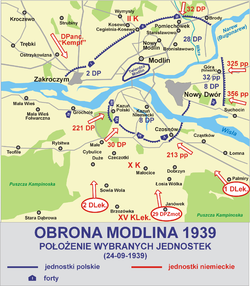II Korpus Armijny (III Rzesza)
| Historia | |
| Państwo | |
|---|---|
| Działania zbrojne | |
| II wojna światowa | |
| Organizacja | |
| Rodzaj sił zbrojnych | lądowe |
| Formacja | |
II Korpus Armijny – jeden z korpusów armijnych okresu III Rzeszy.
Brał udział m.in. w kampanii wrześniowej, w składzie 4 Armii. 13 września został przesunięty w skład 3 Armii.
Żołnierze dowództwa korpusu
- dowódca – gen. Adolf Strauss
Skład
- Wrzesień 1939
- 3 Dywizja Piechoty – dowódca gen. mjr Walther Lichel
- 32 Dywizja Piechoty – dowódca gen. por. Böhme
- II dywizjon 32 pułku artylerii ciężkiej (zmot.)
- 436 dywizjon artylerii ciężkiej (zmot.)
- 42 batalion łączności
Bibliografia
- Konrad Ciechanowski, „Armia POMORZE 1939”
Media użyte na tej stronie
The Imperial Eagle or Emblem of the German Empire (German Reich, used 1935–1945), which features an eagle looking over its right shoulder, that is, looking to the left from the viewer's point of view. It is similar to the Parteiadler or Emblem of the Nationalsozialistische Deutsche Arbeiterpartei (NSDAP; known in English as the National Socialist German Workers' Party, or simply the Nazi Party), but the eagle of the latter is looking over its left shoulder, that is, looking to the right from the viewer's point of view.
(c) Bundesarchiv, Bild 101I-208-0038-15 / Ziesel / CC-BY-SA 3.0
The Imperial Eagle or Emblem of the German Empire (German Reich, used 1935–1945), which features an eagle looking over its right shoulder, that is, looking to the left from the viewer's point of view. It is similar to the Parteiadler or Emblem of the Nationalsozialistische Deutsche Arbeiterpartei (NSDAP; known in English as the National Socialist German Workers' Party, or simply the Nazi Party), but the eagle of the latter is looking over its left shoulder, that is, looking to the right from the viewer's point of view.





